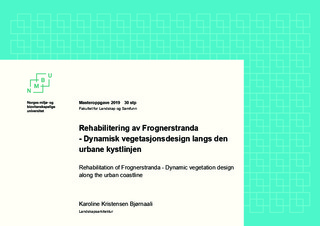| dc.contributor.advisor | Geelmuyden, Anne Katrine | |
| dc.contributor.author | Bjørnaali, Karoline Kristensen | |
| dc.coverage.spatial | Norway, Oslo | nb_NO |
| dc.date.accessioned | 2019-10-15T09:17:45Z | |
| dc.date.available | 2019-10-15T09:17:45Z | |
| dc.date.issued | 2019 | |
| dc.identifier.uri | http://hdl.handle.net/11250/2622177 | |
| dc.description.abstract | Vegetasjon er dynamisk og i stadig forandring. Likevel ligger fokuset ofte på verdiene i vegetasjonens modne stadium, og med et spesifikt sluttresultat i tankene. Den naturlige dynamikken får lite spillerom. Vedlikeholdsbehovet blir stort, og det skal mer til for at strukturen og artssammensetningen får en naturlig karakter. For å få økologisk smarte og robuste naturområder innenfor byggefeltet forutsetter det at naturens dynamikk får en større plass i planleggingen av grøntområder. Med mange nye utfordringer knyttet til arealendringer, overvannshåndtering og endringer i temperatur er det viktig med langsiktige planer som fremmer robuste løsninger for et grønt byliv, med vegetasjon som løfter frem muligheter og kvaliteter i alle livsfaser.
Denne oppgaven utforsker hvordan en dynamisk designstrategi kan implementeres på Frognerstranda i Oslo, med naturen som læremester og vegetasjon som formingselement. Målet er å rehabilitere området som en robust og rekreativ strekning mellom Bygdøy og Oslo sentrum med økt klimaresiliens. Som den travleste sykkelveien i Norge blir Frognerstranda mange folks hverdagsmøte med naturen på vei til og fra jobb. Området preges imidlertid av støy fra E18 og får ikke utnyttet sitt fulle potensiale. Med utgangspunkt i relevant teori presenteres en metode for dynamisk vegetasjonsdesign som testes ut på caseområdet. | nb_NO |
| dc.description.abstract | Vegetation is dynamic and constantly changing. Nevertheless, the focus is often on the values in the mature stage of the vegetation, and with a specific final result in mind. The natural dynamics is neglected. There is a constant need for maintenance, and the structure and the species distribution does not easily get a natural character. In order to obtain ecologically smart and robust solutions within urban areas, more attention towards the nature’s dynamics in the planning of green spaces is neccessary. With many new challenges related to land-use changes, stormwater management and temperature changes, it is important to make long-term plans promoting robust solutions for green cities, with vegetation that highlights opportunities and qualities in all stages of life.
This thesis explores how a dynamic vegetation strategy can be implementet at Frognerstranda in Oslo, with nature as the teacher and vegetation as the shaping element. The goal is to rehabilitate the area as a robust, recreative area between Bygdøy and downtown Oslo with increased climate resilience. As the busiest bicycle path in Norway, Frognerstranda becomes many people’s main encounter with nature in the daily life, on their way to and from work. However, the area is characterized by noise from the much trafficated road, and is not fulfilling its potential. Based on relevant literature a method for dynamic vegetation design is presented and tested. | nb_NO |
| dc.language.iso | nob | nb_NO |
| dc.publisher | Norwegian University of Life Sciences, Ås | nb_NO |
| dc.rights | Attribution-NonCommercial-NoDerivatives 4.0 Internasjonal | * |
| dc.rights.uri | http://creativecommons.org/licenses/by-nc-nd/4.0/deed.no | * |
| dc.subject | Vegetasjonsstruktur | nb_NO |
| dc.subject | Kreativ skjøtsel | nb_NO |
| dc.subject | Økologi | nb_NO |
| dc.subject | Plantesamfunn | nb_NO |
| dc.subject | Havnepromenader | nb_NO |
| dc.title | Rehabilitering av Frognerstranda : dynamisk vegetasjonsdesign langs den urbane kystlinjen | nb_NO |
| dc.title.alternative | Rehabilitation of Frognerstranda : dynamic vegetation design along the urban coastline | nb_NO |
| dc.type | Master thesis | nb_NO |
| dc.subject.nsi | VDP::Humaniora: 000::Arkitektur og design: 140::Landskapsarkitektur: 147 | nb_NO |
| dc.source.pagenumber | 102 | nb_NO |
| dc.description.localcode | M-LA | nb_NO |

